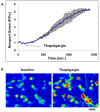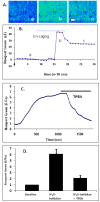Zinc release from thapsigargin/IP3-sensitive stores in cultured cortical neurons
- PMID: 20504366
- PMCID: PMC2897781
- DOI: 10.1186/1750-2187-5-5
Zinc release from thapsigargin/IP3-sensitive stores in cultured cortical neurons
Abstract
Background: Changes in ionic concentration have a fundamental effect on numerous physiological processes. For example, IP3-gated thapsigargin sensitive intracellular calcium (Ca2+) storage provides a source of the ion for many cellular signaling events. Less is known about the dynamics of other intracellular ions. The present study investigated the intracellular source of zinc (Zn2+) that has been reported to play a role in cell signaling.
Results: In primary cultured cortical cells (neurons) labeled with intracellular fluorescent Zn2+ indicators, we showed that intracellular regions of Zn2+ staining co-localized with the endoplasmic reticulum (ER). The latter was identified with ER-tracker Red, a marker for ER. The colocalization was abolished upon exposure to the Zn2+ chelator TPEN, indicating that the local Zn2+ fluorescence represented free Zn2+ localized to the ER in the basal condition. Blockade of the ER Ca2+ pump by thapsigargin produced a steady increase of intracellular Zn2+. Furthermore, we determined that the thapsigargin-induced Zn2+ increase was not dependent on extracellular Ca2+ or extracellular Zn2+, suggesting that it was of intracellular origin. The applications of caged IP3 or IP3-3Kinase inhibitor (to increase available IP3) produced a significant increase in intracellular Zn2+.
Conclusions: Taken together, these results suggest that Zn2+ is sequestered into thapsigargin/IP3-sensitive stores and is released upon agonist stimulation.
Figures





Similar articles
-
Intracellular zinc distribution in mitochondria, ER and the Golgi apparatus.Int J Physiol Pathophysiol Pharmacol. 2016 Apr 25;8(1):35-43. eCollection 2016. Int J Physiol Pathophysiol Pharmacol. 2016. PMID: 27186321 Free PMC article.
-
Volatile anesthetic-induced efflux of calcium from IP3-gated stores in clonal (GH3) pituitary cells.Anesthesiology. 1994 Jun;80(6):1379-89; discussion 27A-28A. Anesthesiology. 1994. PMID: 8010482
-
Vectorial Ca2+ flux from the extracellular space to the endoplasmic reticulum via a restricted cytoplasmic compartment regulates inositol 1,4,5-trisphosphate-stimulated Ca2+ release from internal stores in vascular endothelial cells.Biochem J. 1993 Oct 15;295 ( Pt 2)(Pt 2):357-66. doi: 10.1042/bj2950357. Biochem J. 1993. PMID: 8240234 Free PMC article.
-
Modulation of intracellular free Ca2+ concentration by IP3-sensitive and IP3-insensitive nonmitochondrial Ca2+ pools.Cell Calcium. 1989 Jul;10(5):325-36. doi: 10.1016/0143-4160(89)90058-4. Cell Calcium. 1989. PMID: 2548726 Review.
-
Mercurial-induced alterations in neuronal divalent cation homeostasis.Neurotoxicology. 1996 Spring;17(1):47-61. Neurotoxicology. 1996. PMID: 8784818 Review.
Cited by
-
Rising intracellular zinc by membrane depolarization and glucose in insulin-secreting clonal HIT-T15 beta cells.Exp Diabetes Res. 2012;2012:190309. doi: 10.1155/2012/190309. Epub 2012 Mar 21. Exp Diabetes Res. 2012. PMID: 22536213 Free PMC article.
-
The change of intracellular zinc distribution after strong acid challenge.Int J Physiol Pathophysiol Pharmacol. 2021 Jun 15;13(3):94-101. eCollection 2021. Int J Physiol Pathophysiol Pharmacol. 2021. PMID: 34336133 Free PMC article.
-
The role of Zn2+ in shaping intracellular Ca2+ dynamics in the heart.J Gen Physiol. 2023 Jul 3;155(7):e202213206. doi: 10.1085/jgp.202213206. Epub 2023 Jun 16. J Gen Physiol. 2023. PMID: 37326614 Free PMC article. Review.
-
Delineating Zinc Influx Mechanisms during Platelet Activation.Int J Mol Sci. 2023 Jul 20;24(14):11689. doi: 10.3390/ijms241411689. Int J Mol Sci. 2023. PMID: 37511448 Free PMC article.
-
Intracellular zinc distribution in mitochondria, ER and the Golgi apparatus.Int J Physiol Pathophysiol Pharmacol. 2016 Apr 25;8(1):35-43. eCollection 2016. Int J Physiol Pathophysiol Pharmacol. 2016. PMID: 27186321 Free PMC article.
References
LinkOut - more resources
Full Text Sources
Miscellaneous

